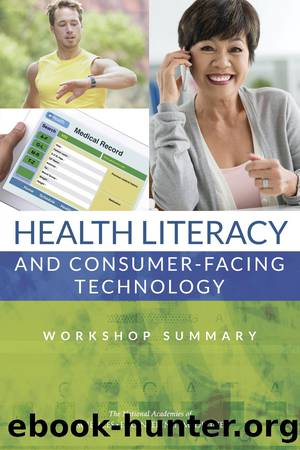Health Literacy and Consumer-Facing Technology: Workshop Summary by Joe Alper

Author:Joe Alper
Language: eng
Format: epub
Publisher: The National Academies Press
Published: 2015-11-06T00:00:00+00:00
As Ricciardi and others mentioned, Rein said there is a tremendous appetite on the part of patients and consumers to engage in this space. A report from the PricewaterhouseCoopers Health Research Institute stated that 47 percent of consumers agree that mobile devices can be used more effectively to coordinate care, and that 65 percent of consumers with one or more health apps on their mobile devices use them at least once weekly. Half of the consumers surveyed said they would be likely to use consumer devices to perform self-evaluations and 56 percent said they would be comfortable having their health data shared if doing so would improve care coordination (PricewaterhouseCoopers, 2014). Rein noted that the ONC and the National Partnership for Women and Families each released survey results over the past year that corroborate and extend these findings.
Given the appetite consumers have for eHealth applications, it is important to consider the risks and whether those risks are evenly distributed across all constituents. Loss of privacy is the risk that gets the most attention and it can take two forms: (1) personal identification and blind discrimination, or (2) discrimination by association. As an example of the former, Rein noted how purchasing an item online suddenly seems to trigger a host of related content appearing on other websites. Discrimination by association refers to a characteristic that a person might have that is associated with something else, such as prior incarceration. Another risk is loss of control of oneâs own information, and to some extent, this may have happened already. Diminished access to potentially beneficial information or treatment is a risk that is associated with the fact that many vulnerable populations may not get access to care because they cannot purchase an app or device and have to relinquish some level of control in order to gain access to something they believe they need medically. Rein said these risks are not evenly distributed.
There is no comprehensive framework for health information privacy and security, Rein said. Although this has been said many times, it bears repeating, she explained. Societal norms informed by the Hippocratic Oath, together with legal protections afforded by the Health Insurance Portability and Accountability Act (HIPAA), the Genetic Information Nondiscrimination Act (GINA), and the Common Rule, are only in force for data generated by the health system. For patient- and consumer-generated data, there are few protections and many points of potential risk, a situation that Rein characterized as being like the Wild West.
âGiven all of this,â said Rein, âI think the question becomes what things are health literacy sensitive? That is, if we apply basic health literacy concepts and practices, could we reasonably expect consumers to take some different action? Conversely, are there things that are so complex or so opaque or where there is no transparency that it is just really too much to expect that consumers would be able to engage or interact in that way?â Consumer use of mobile apps provides one example of something that is potentially health literacy sensitive.
Download
This site does not store any files on its server. We only index and link to content provided by other sites. Please contact the content providers to delete copyright contents if any and email us, we'll remove relevant links or contents immediately.
Parents as Care Managers by Gillian Bridge(697)
The Tapestry of Memory: Unraveling the Threads of the Mind by Bittner Karis & Chianese Gabriella & Priede PhD David L(537)
So Young, So Sad, So Listen: A Parents' Guide to Depression in Children and Young People by Philip Graham Nick Midgley(531)
Lucid Dying by Sam Parnia(470)
Vital Signs by Izzy Lomax-Sawyers(443)
Prepare the TCM License exam in a month Vol. 3: Acupuncture theory - channels, points, techniques and treatments(California, NCCAOM, Canadian exam) by Woosen Ur(390)
Oxford Textbook of Global Public Health by Roger Detels;Quarraisha Abdool Karim;Fran Baum;Liming Li;Alastair H Leyland;(358)
The Censorship of Second Opinions: How the politics of "misinformation" captured healthcare during the Covid-19 pandemic by Ariel Herron(342)
IVF Got This by Colette Centeno Fox(340)
Wilderness and Survival Medicine by Ellis Chris Breen & Dr Craig(280)
Introduction to Social Work Practice : A Practical Workbook by Herschel Knapp(279)
Eating and Growth Disorders in Infants and Children by Joseph L. Woolston(274)
How Data Happened by Unknown(257)
Boxed Set 1 Dermatology by Dr Miriam Kinai(256)
Selective Oxidation Catalysts Obtained by the Immobilization of Iron (III) Porphyrins on Layered Hydroxide Salts by Fernando Wypych Shirley Nakagaki & Guilherme Sippel Machado(246)
Zika Virus Biology, Transmission, and Pathways by Colin R. Martin(241)
Snake Oil: How Xi Jinping Shut Down the World by Michael P. Senger(237)
Positive health: 100+ research-based positive psychology and lifestyle medicine tools to enhance your wellbeing by Jolanta Burke Pádraic J. Dunne Trudy Meehan Ciaran A. O'Boyle Christian van Nieuwerburgh(232)
Global Health Governance and Commercialisation of Public Health in India by Anuj Kapilashrami Rama V. Baru(215)
